Do flies really throw up on your food when they land on it?
Jamie Theobald receives funding from the National Science Foundation: IOS-1750833.
Ravindra Palavalli-Nettimi does not work for, consult, own shares in or receive funding from any company or organisation that would benefit from this article, and has disclosed no relevant affiliations beyond their academic appointment.
Partners
Florida International University provides funding as a member of The Conversation US.
Languages

Curious Kids is a series for children of all ages. If you have a question you’d like an expert to answer, send it to [email protected].
Do flies really throw up on my food when they land on it? – Henry E., age 10, Somerville, Massachusetts
Imagine you’re at a picnic and just about to bite into your sandwich. Suddenly you spot a fly headed your way, homing in on your food with help from its compound eyes and antennae. It manages to escape your swatting, lands on the sandwich and then seems to throw up on it!
It can look kind of gross, but the fly might be just airing out its own digested food, or spitting on yours.
Most of the over 110,000 known fly species have no teeth, so they cannot chew solid food. Their mouthparts are like a spongy straw. Once they land on your food, they need to release digestive juices to liquefy it into a predigested, slurpable soup they can swallow. In short, some flies are on a liquid diet.
To fit more food in their stomachs, some flies try to reduce the liquid in what they have already eaten. They regurgitate food into vomit bubbles to dry it out a bit. Once some water has evaporated they can ingest this more concentrated food.
Human beings don’t need to do all this spitting and regurgitating to get nutrients out of our food. But you do produce a digestive juice in your saliva, an enzyme called amylase, which predigests some of the sandwich bread while you chew. Amylase breaks down starch, which you can’t taste, into simple sugars like glucose, which you can taste. That’s why bread gets sweeter the longer you chew it.
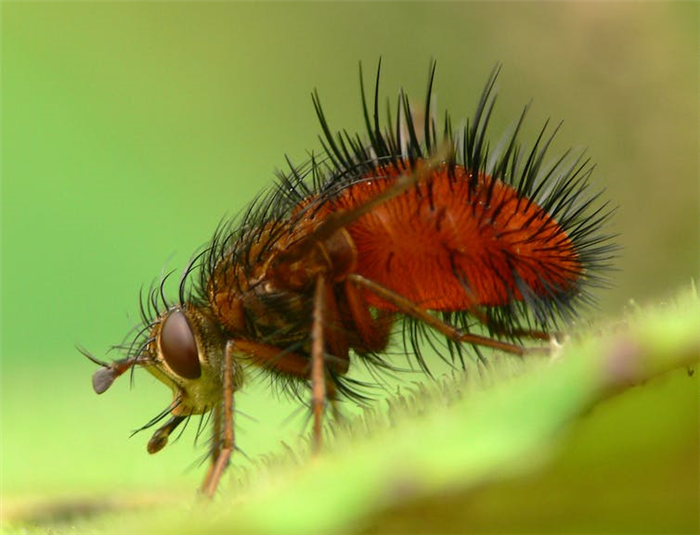
Did you know flies can taste food without their mouths? As soon as they land, they use receptors on their feet to decide whether they’re on something nutritious. You may have noticed a fly rubbing its legs together, like a hungry customer getting ready to devour a meal. This is called grooming – the fly is essentially cleaning itself, and may also clean the taste sensors on the bristles and fine hair of its feet, to get a better idea of what is in the food it has landed on.
Should you trash food a fly’s landed on?
When a fly touches down on your sandwich, that’s probably not the only thing it’s landed on that day. Flies often sit on gross stuff, like a dumpster or decomposing food, that’s full of microbes. The germs can hitch a ride and, if the fly stays put long enough, hop onto your meal. This is much more dangerous than their saliva because some of the microbes can cause diseases, like cholera and typhoid. But if the fly doesn’t stay longer than a few seconds the chances of microbes transferring are low, and your food is probably fine.
To keep insects from landing on your food, you should always cover it. If your house is infested with flies, you can use simple traps to get rid of them. Carnivorous plants can also eat the flies and help control their population.
Are flies good for anything?
Spitting on food and spreading diseases sounds disgusting, but flies aren’t all bad.
Watch closely the next time you’re outside and you might be surprised by how many flies visit flowers to get nectar. They’re an important group of pollinators, and many plants need flies to help them reproduce.
Flies are also a good source of food for frogs, lizards, spiders and birds, so they’re a valuable part of the ecosystem.
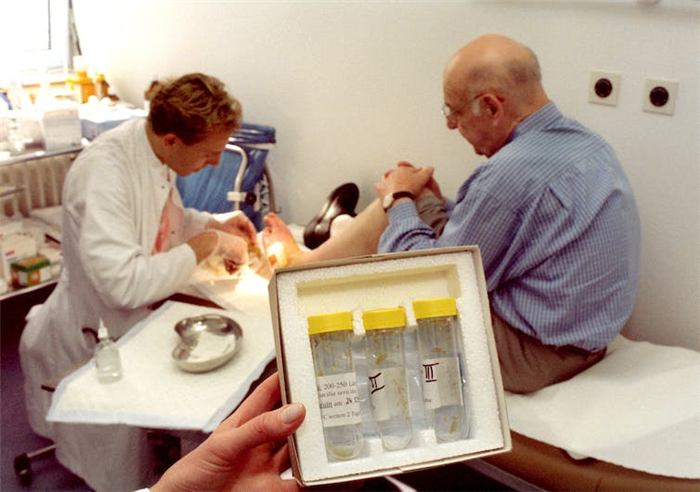
A doctor uses sterile maggots like those in these tubes to clean a patient’s foot wound. Norbert Försterling/picture alliance via Getty Images
Some flies have medical uses, too. For example, doctors use blow fly maggots – the young, immature form of flies – to remove decomposing tissue in wounds. The maggots release antiviral and antimicrobial juices, and these have helped scientists create new treatments for infections.
More importantly, the fruit flies you may have seen flying around ripe bananas in your kitchen have been invaluable in biological research. Biomedical scientists from all over the world study fruit flies to find causes and cures for diseases and genetic disorders. And in our lab, we study what the world looks like to insects, and how they use their vision to fly. This knowledge can inspire engineers to build better robots.
So, although it’s a nuisance to shoo flies away from your sandwich, maybe you can spare a few bits of your lunch?
Hello, curious kids! Do you have a question you’d like an expert to answer? Ask an adult to send your question to [email protected]. Please tell us your name, age and the city where you live.
And since curiosity has no age limit – adults, let us know what you’re wondering, too. We won’t be able to answer every question, but we will do our best.
What Do House Flies Eat? 15+ Foods They Feast On
There are around 240,000 different species of flies in the world. One of the most common types of flies is the house fly. They are commonly encountered indoors, hence the name, and are of hygiene concern for humans as they are known to carry pathogenic organisms, which they transmit, and as a result, can cause various diseases such as typhoid fever, E. coli, cholera, shigellosis, and diarrhea, to name a few.
In a survey conducted by Orkin, the result showed that 61% of the participants will most likely eat the food landed on by a fly than the food that had been crawled over by a cockroach. However, if you know better about the food house flies actually dive themselves into, you surely won’t be a part of that 61%. This begs the question: what do house flies eat?
What Do House Flies Eat?
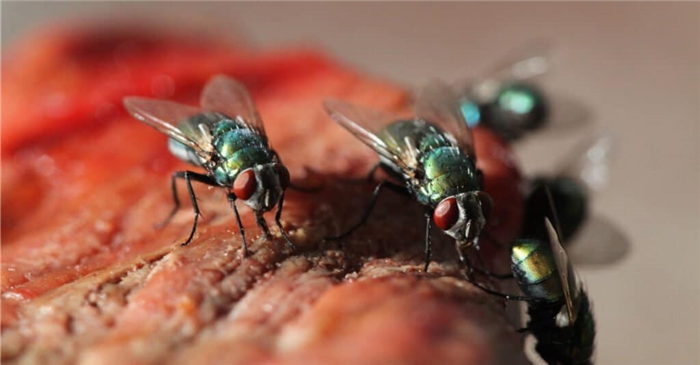
House flies are carnivores that eat decaying bodies of animals and manure as their primary food.
House flies eat rotting fruits, vegetables, decomposing waste, animal and human feces and decaying bodies, as well as raw and spoiled meat.
Generally carnivores, house flies consume decaying bodies of animals and manure as their primary food. They often feast on your leftovers, rotting human food, or anything that is pungent enough to attract their smell.
Here is a list of the food house flies mostly consider eating:
- Overripe fruits
- Overripe vegetables
- Rotting fruits
- Rotting vegetables
- Animal and human feces
- Animal and human carcasses
- Decomposing waste
- Pet waste
- Rotting food
- Milk
- Sugary products
- Spoiled meat
- Flower nectar
- Raw meat
- Plant secretions
Animal matter, carrion, or feces are particularly appealing to house flies because the odor is strong, making it easy for them to locate. House flies will eat basically anything wet or decaying, but they are particularly drawn to pet excrement.
Adult house flies also consume rotting waste, fruits, and vegetables, sugar, and nectar from flowers. They will occasionally consume honeydew that has been left behind by aphids. House flies do not have chewing mouthparts, hence they cannot chew their food.
What Do House Fly Larvae Eat?
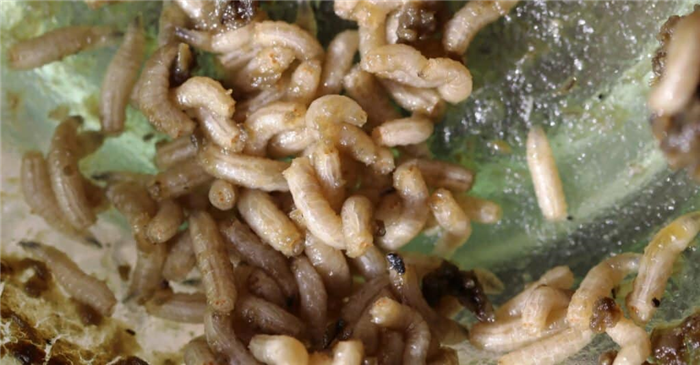
Maggots are voracious devourers of dead and rotting matter.
House fly larvae, known as maggots, eat decaying carcasses, leftover food, fermented substances, and rotting meat and vegetables that can be found near the insect’s breeding location.
When they open their mouths, they show an innate hook-like feature, which they often use to scrape small solid particles of food from their mouths and swallow them.
How Do House Flies Eat their Food?
House flies are unable to bite or sting because they lack teeth and a stinger. Their mouths are more like sponges, soaking up whatever they eat.
They can only consume liquids, but they are capable of transforming many solid items into liquids by spitting or vomiting on them. As house flies are unable to chew, they must disintegrate solid food into liquid, or at the very least into particles measuring less than 0.45 millimeters. Their mouths are fashioned like straws, allowing them to suck up their food easily and efficiently.
The mouthparts of the vast majority of flies are characterized by two sponge pads and a straw. There are carved canals in their lips that allow fluids to seep in from the two spongy pads that are linked to the lower lip of the fly, or the labella. To achieve this, the fly disgorges saliva from its stomach, which softens the food until it is digestible enough for the house fly’s stomach. Once the process is done, the house fly uses its special mouth part called proboscis to suck on the liquid meal. Proboscis is elongated, helping flies suck flexibly.
Can House Flies Taste their Food?
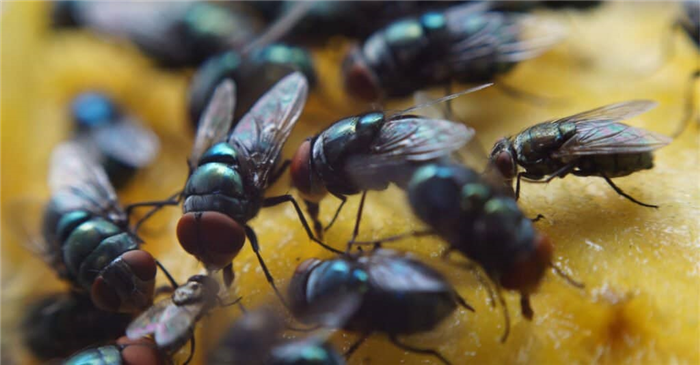
House flies taste their foods with their feet and consume with their mouths.
With feet that are 10 million times more sensitive to sugar than the human tongue, house flies taste with their feet, and consume with their mouths. And it is for this very reason that they are constantly creeping on your meals. Because they also “taste”, and in this case “walk”, on rotting meat and feces, the last area you want them creeping on is the food you’re going to eat — not to mention the fact that flies are continuously defecating on their food!
Who Eats House Flies?
House flies are prey to a wide range of animals too, such as bigger insects, spiders, birds, reptiles, amphibians, and sometimes even mammals.
Though labeled carnivorous, house flies don’t really hunt for prey, unlike most carnivores. However, that does not mean they are safe from predators, and no, this is not about the man-made fly traps that usually kill them.
The “fly predator,” commonly called fly parasites, are one of the most common beneficial insects that eat house flies. Fly predators are small wasps that eliminate house flies and other species of flies during their larval stage.
As natural enemies of nuisance flies, these tiny fly hunters are nature’s first line of defense against them. In order to deposit her eggs, the female fly predator locates a host pupa, drills through its cocoon, and then lays multiple eggs inside of it. The parasitoids that develop as a result of this process consume the pupa and destroy it later on.
Are House Flies Dangerous to Humans?
The house fly is probably not one of the first insects that jumps to mind when you try to think of the most harmful pests on the planet. Most people associate “dangerous pests” to stinging insects such as wasps and bees.
While it is true that flies seldom bite or sting, the fact that they frequently hover and land on dead animals, manure, rotting food, and rubbish makes them a potential health hazard. The fact that they visit those locations often before touching your food means that they are more likely to take up and spread diseases (as well as over 200 viruses and parasites) that are dangerous to humans.
Luckily, there are various strategies you may employ to keep house flies away, protecting you and your family from contracting any of the diseases that are carried by the small pests.
What Do Flies Eat?
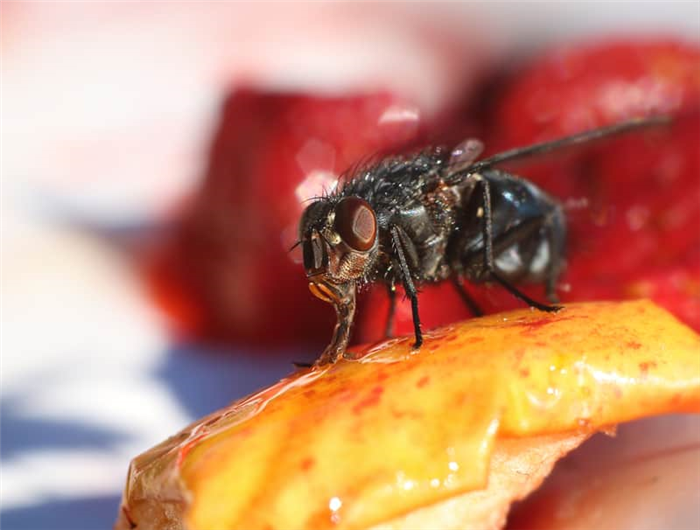
The “fly diet” isn’t some new trend to help you lose weight. That would be pretty gross considering the rotten nature of fly food. The following FAQs explain a fly’s diet, giving you answers to questions such as “what do flies eat?” These answers will help you understand why fly control is so important for you and your family’s health.
What do flies eat?
Just as there are thousands of fly species, flies have many food sources and preferences. The feeding habits of one species varies greatly from another. For example, mosquitoes are a type of fly that feed on decaying organic matter in the water while they are in the larval stage. As adults, they turn to plant nectar for sustenance, though they are better known for sucking blood.
Tachnid flies also feed on plant nectar as adults, but in their larval stage, they dine on other insects. Hessian flies eat grass, while bot flies eat animal tissue. The most recognizable fly – the house fly – sustains itself on rotting food and meat while at the larval stage. The decaying matter is preferably peppered with human, pig or horse feces, if the house fly larvae has its say. As an adult, the house fly prefers sweets, liquids and rotting fruit. And that explains why the “fly diet” was never invented.
How does the house fly eat?
Most flies have mouthparts that are best described as two sponge pads and a straw. Their lips have grooved channels that allow liquid to flow in from the two fleshy pads attached to the fly’s lower lip (the labella). Since they cannot chew, flies have to dissolve solid food into liquid, or at least into particles measuring 0.45 millimeters or less. To do this, the fly regurgitates saliva from its stomach, which dissolves the food until it is digestible. The house fly then uses its proboscis to suck up the liquefied food.
Though they eat with their mouths, house flies taste with their feet. This is why they are always crawling on your food. Since they also “taste” spoiled meat and feces, the last place you want them crawling is on food you’re about to put in your mouth – not to mention flies constantly defecate.
Do fruit flies eat fruit?
Contrary to popular belief, fruit flies don’t actually eat fruit. Instead, they eat the yeast cells that grow on fruit, particularly rotting fruit. That’s why you only see them pop up when fruit gets old, or around garbage storage and disposal areas, since that’s often where people discard rotten fruit.
Flies are dirty, annoying and some species can bite. If you have a fly problem, don’t try to starve them out with some crazy fly diet or home remedy.
House Flies
House flies earned their name by being the most common household fly. With hairy black bodies, translucent wings and big brown eyes, house flies can be found across the globe. They are incredibly fast and agile, and their large eyes allow them to see nearly everything around them. These pests generally live between 15 and 25 days.
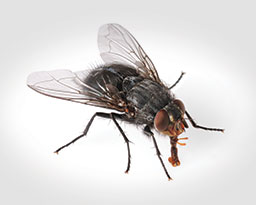
| Color | Dark gray |
| Legs | 6 |
| Shape | Small Oval |
| Size | 1/4″ |
| Antennae | False |
House Fly Habits
House flies are highly attracted to manure, so they are often found around farms. These pests generally stay within a mile or two of their birthplace, but they have been known to travel up to 20 miles in search of food. House flies enjoy being in the sun, and will perch in sunny spots around your home — retreating to rest at night.
House flies are only able to ingest liquids, but they can turn solids into liquids by spitting on it. They especially enjoy sweet and fermenting fruits. And interestingly enough, house flies’ tastebuds are located on their hair and feet. These sensors are 10 million times more sensitive to sugar than the human tongue.
How Long Can a House Fly Go Without Food or Water?
House flies can survive without food or water for two to three days.
House flies do not sting or bite, but they can be a substantial threat to humans. These pests carry up to 100 different disease-causing germs and can be incredibly harmful to your health, so it’s important to make sure these flies stay away from your home.
Signs You Have a House Fly Infestation
The most common sign of a house fly infestation is finding these pests flying around your home, particularly in locations where food is found. If you suspect you may have an infestation, investigate your food sources for potential eggs or larvae.
The best way to prevent an infestation is to keep adult flies from entering your home. Place mesh screens on all of your windows and doors, and be sure to diligently clean your home, especially areas where food is frequently prepared or consumed. Additionally, hanging a plastic bag of water from your doorframe will discourage house flies from entering your home, as the presence and movement will mess with their vision and deter them from coming inside.
How to Get Rid of House Flies
To keep your home free of flies, remove all potential food sources and sanitize your house thoroughly. While spray and powder insecticides will work, the best way to eradicate house flies is to use fly traps, such as sticky strips or light traps.
If house flies have been making your home life unpleasant, don’t hesitate to call the professionals at Arrow. Fill out the form below to make your home yours again.
Our proprietary process, the STEPS® Total Protection System™, looks closely at the total picture, top to bottom, inside and out. We carefully conduct a home pest inspection of your property looking for potential entry points and signs of pest activity that are often difficult to detect. This comprehensive pest and termite inspection is the only way to determine the real root of a pest problem, as well as the best way to solve it.
For a no obligation free pest control quote for your home, please complete the form below. We’ll take it from there. One of our trained professionals will contact you upon receiving your request and set up a date and time that is convenient for you. Thank you for your interest in our free home pest inspection.
Are flies good for anything?
Spitting on food and spreading diseases sounds disgusting, but flies aren’t all bad.
Watch closely the next time you’re outside and you might be surprised by how many flies visit flowers to get nectar. They’re an important group of pollinators, and many plants need flies to help them reproduce.
Flies are also a good source of food for frogs, lizards, spiders and birds, so they’re a valuable part of the ecosystem.
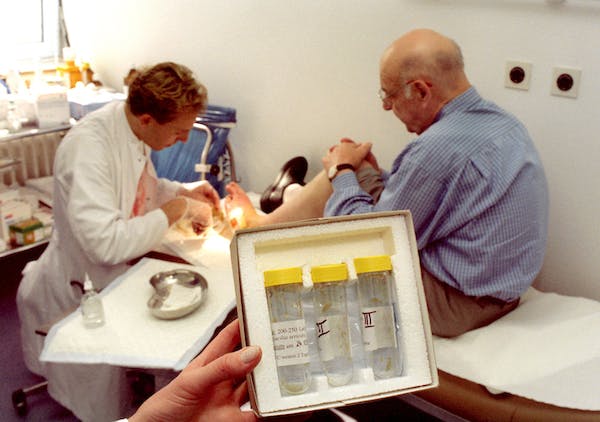
A doctor uses sterile maggots like those in these tubes to clean a patient’s foot wound. Norbert Försterling/picture alliance via Getty Images
Some flies have medical uses, too. For example, doctors use blow fly maggots – the young, immature form of flies – to remove decomposing tissue in wounds. The maggots release antiviral and antimicrobial juices, and these have helped scientists create new treatments for infections.
More importantly, the fruit flies you may have seen flying around ripe bananas in your kitchen have been invaluable in biological research. Biomedical scientists from all over the world study fruit flies to find causes and cures for diseases and genetic disorders. And in our lab, we study what the world looks like to insects, and how they use their vision to fly. This knowledge can inspire engineers to build better robots.
So, although it’s a nuisance to shoo flies away from your sandwich, maybe you can spare a few bits of your lunch?
Hello, curious kids! Do you have a question you’d like an expert to answer? Ask an adult to send your question to [email protected]. Please tell us your name, age and the city where you live.
And since curiosity has no age limit – adults, let us know what you’re wondering, too. We won’t be able to answer every question, but we will do our best.
This article is republished from The Conversation under a Creative Commons license. Read the original article.
